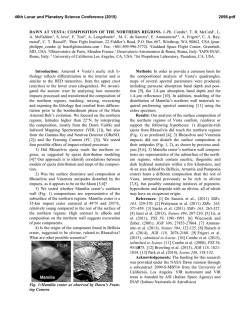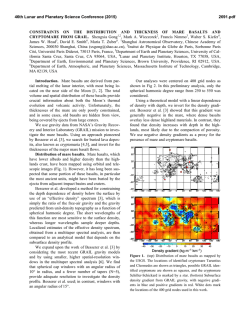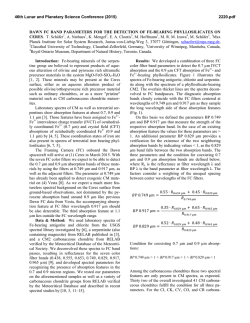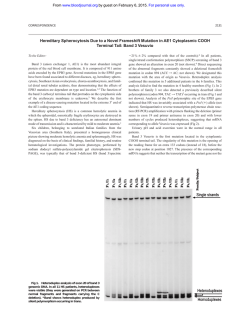
ANALYSIS OF PYROXENE MINERALOGY OF BASALTS AT
46th Lunar and Planetary Science Conference (2015) 1407.pdf ANALYSIS OF PYROXENE MINERALOGY OF BASALTS AT HANSTEEN-BILLY, MOON THROUGH CHANDRAYAAN-I MOON MINERALOGY MAPPER (M3). Mamta Chauhan, Satadru Bhattacharya and Prakash Chauhan, Space Applications Centre, Indian Space Research Organisation, Ahmedabad – 380 015, India ([email protected]). Introduction: Mare basalts on the Moon derived from partial melting of its mantle occurs in a wide range of composition. The Oceanus Procellarum area of the Moon is dominantly covered by these basaltic flows and characterized by emplacement of vast expanses of various mare units ranging from Nectarian to Copernican period (3.9-1.2 Ga) as mapped by earlier remote observations [1, 2]. Pyroxene, the most abundant phase in mare basalts is a solid solution of various minerals [3] and are characterized by two widely separated absorption features in near infra-red region whose position and shapes are the results of its bulk composition, texture, and cooling history [4]. Therefore, this mineral provide useful information regarding the composition and thermal history of the host rocks. In the present study, compositional analysis of basaltic units have been carried out in the Hansteen-Billy area using high-resolution hyperspectral data from Chandrayaan-1 Moon Mineralogy Mapper (M3) instrument [5] based on pyroxene mineralogy. The study area lies near the southwest edge of the Oceanus Procellarum, extending roughly between 55oW-16.5oS and characterized by the presence of craters Hansteen and Billy and a prominent domal feature, Hansteen alpha. Methodology: Three mare units (INm, Im and Em) (Fig. 1a) are delineated in this area that corresponds to the chrono-stratigraphic units of [6]. The youngest basaltic unit belonging to Eratosthenian period (Em) and is confined to crater Billy and appears bright while, the Imbrian period (Im) unit is somewhat dull and the oldest unit (INm) of Nectarian age is mostly degraded. To represent the spectral variability amongst the three basaltic units, Integrated Band Depth (IBD) mosaic has been generated (Fig. 1b) using equation given by Mustard et al. [7]. These mare units are analyzed for their composition using the diagnostic absorption features of the abundant mineral phases i.e, olivine and pyroxenes as characterized by [8-10]. For quantification of the spectra and to determine their relative mafic mineral abundances (olivine/orthoand/or clinopyroxene) and pyroxene chemistry spectral band parameters, are computed. Band Continuum removal is performed by fitting a straight line continuum tangent on both side of the absorption band, I and II separately and dividing the spectra by the respective continuum. Band center is calculated by fitting a third order polynomial equation to the bottom of the continuum-removed absorption feature between 10 and 20 data points on either side of a visually determined min- imum or center. Band area is calculated as the area between the continuum slopes and the data points. Results: The normal and continuum-removed reflectance spectra from the fresh craters sampled from each of the three basaltic units are presented in Figure 2. To estimate the relative abundances of pyroxene and olivine in the basalts the band area ratio of Band II vs Band I (BAR) [11] have been calculated. The calculated BAR value ranges from 2.2-3 for all the three mare units indicating pyroxene dominated lithologies in the area. Besides, pyroxenes a weaker absorption band could be noted in the spectra of the basalts around 650 nm (Fig. 2). This absorption band could perhaps be attributed to the presence of chromium in the basalts. As in both high- and low-Ca pyroxenes the absorption bands in reflectance spectra at 0.6–0.68 mm regions is attributed to the presence of chromium in octahedral coordination in the M1 site [e.g., 12-14]. The Band I and Band II centre obtained from the reflectance spectra of fresh craters of basalts are plotted in a Band I/Band II center scatter plot of ortho-and clino-pyroxenes (Fig. 3) along with the compositional data of pure ortho-and clino-pyroxenes of Adams and Klima [15-17] for comparison. The band center values of the spectra from INm basalts ranges from 910 to 950 nm for Band I and 1900–2100 nm for Band II absorption features. They appears to fall in the orthopyroxene range. Data from the Im basalts shows Band I center values varying from 960 to 990 nm and Band II from 2160 to 2270 nm characterizing them as high-Ca pyroxenes. Whereas, for Em, the Band I center range from 951 to 991 nm and 2230-2340 indicating their high-Ca bearing nature (Fig. 3). The Band II centre in Em basalts are indicative of their Cr-bearing nature as the wavelength position is more longwards. Crdiopside displays the 2000-nm absorption bands at longer than expected wavelength [13, 14]. In addition the additional absorption band near 650-680 nm is also indicative of Cr-diopside and are more common in lunar samples while rare in terrestrial basalts [14]. The spectral band parameters of pyroxene obtained from reflectance spectra are analysed for estimating the Enstatite (En), Ferrosilite (Fs) and Wollastonite (Wo) content of pyroxenes using calibration equations formulated by [15] for compositional assessment of pyroxenes. The pyroxene composition thus obtained for the three mare units are projected over the Di-En-Hd-Fs quad for showing their composition and determination their formation temperatue [16]. 46th Lunar and Planetary Science Conference (2015) 1407.pdf 1050oC for INm, 1000o-700oC for Im, 1000o-600oC for Em basalts. It indicates that basaltic evolution in the area with time probably would have occurred by assimilating plagioclase in the source. Figure 4 Figure 1 Figure 2 Figure 3 Conclusions: The calculated average pyroxene composition for INm basalts is En39.2Fs45.4Wo15.4 indicating a pigeonitic affinity and suggests a primitive basaltic source. Pyroxene composition of Im En46.32Fs17.4Wo35.7 and Em basalts En44.3Fs16.15Wo39.46 indicates composition close to calcic augite to diopside suggesting their highland affinity.Temperature ranges from 1100o- Figure 1. (a) M3 False colour composite (R=930, G=1229 and B=1578-nm bands) showing basaltic units belonging to different ages (b) M3 IBD mosaic of Hansteen-Billy region generated by assigning red, green and blue colour to 1000 nm, 2000 nm and 1578nm bands respectively. Figure 2 Normal and Continuum removed spectras of pyroxenes from Nectarian (INm) (a and b), Imbrium (Im) (c and d) and Eratosthene (Em) basalts (e and f). Figure 3. Band I-Band II ratio image showing plotting of three basaltic units of the Hansteen-Billy area along with data for pure ortho-and clino-pyroxenes of Adams (1974) and Klima (2007, 2010). Figure 4. Composition and equlibrium pyroxene temperature for the basaltic units of Hansteen-Billy region projected over pyroxene compositional quadrilateral overlain by geotherms determined by Linsley and Anderson (1983). References: [1]Wilhelms D. E. and McCauley J.F. (1971) Map I,703,U.S. Geol. Surv. [2] Hiesinger H. et al. (2003) JGR 108, E7, 5065. [3] Basaltic Volcanism Study Project (1981) Pergamon Press, Inc., New York. [4] Klima R. L. et al. (2007) Meteorit. Planet. Sci,. 42, 235-253. [5] Boardman J. et al. (2011) JGR 116, E00G14.[6] Wegner R. et al. (2010) JGR 115, E06015. [7] Mustard J. F. et al. (2011) JGR 116, E00G12. [8] Burns R. G. (1993) 2nd ed., Cambr. Univ. Press, New York [9] Klima, R. L. (2007) Meteorit. Planet. Sci. 42, 235-253. [10] Klima, R. L.(2011) Meteorit. Planet. Sci. 46, 3, 379-395. [11] Cloutis E. A. and Gaffey M. J. (1991) JGR 96, 22,809-22,826. [12] Mao H. K. et al. (1972) Year Book Carnegie Inst. Washington, 71, 538541. [13] Hazen, R. M. et al. (1978) Proc. Lunar Sci. Conf. 9, 2919-2934. [14] Cloutis E. A. et al. (2002) JGR 107, E6, 5039. [15] Gaffey M. J. et al. (2002) Univ. Arizona Press, 183-204. [16] Linsley D. H. and Anderson D. J. (1983) JGR 88, A887-A906.
© Copyright 2025







